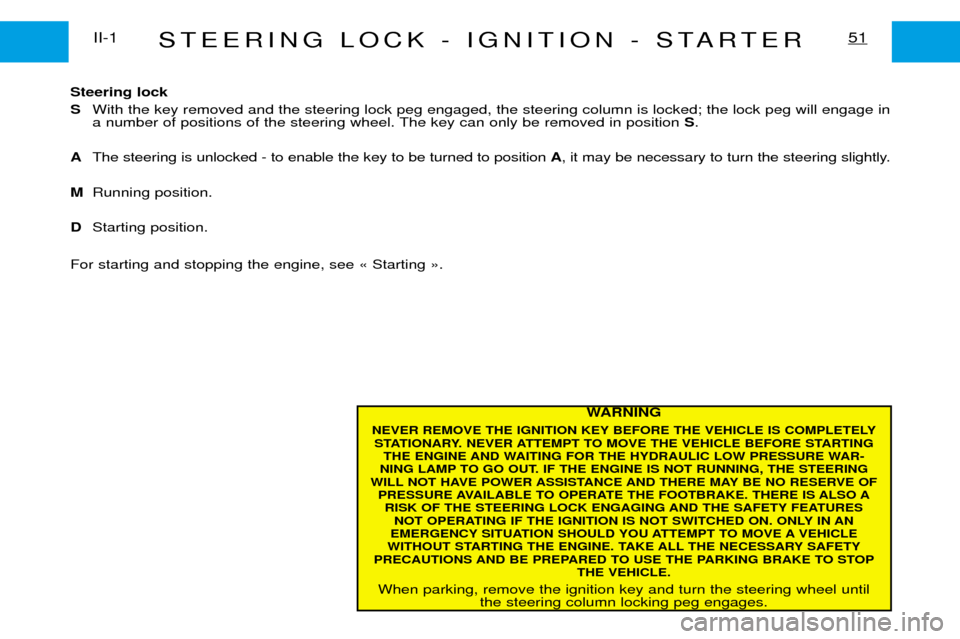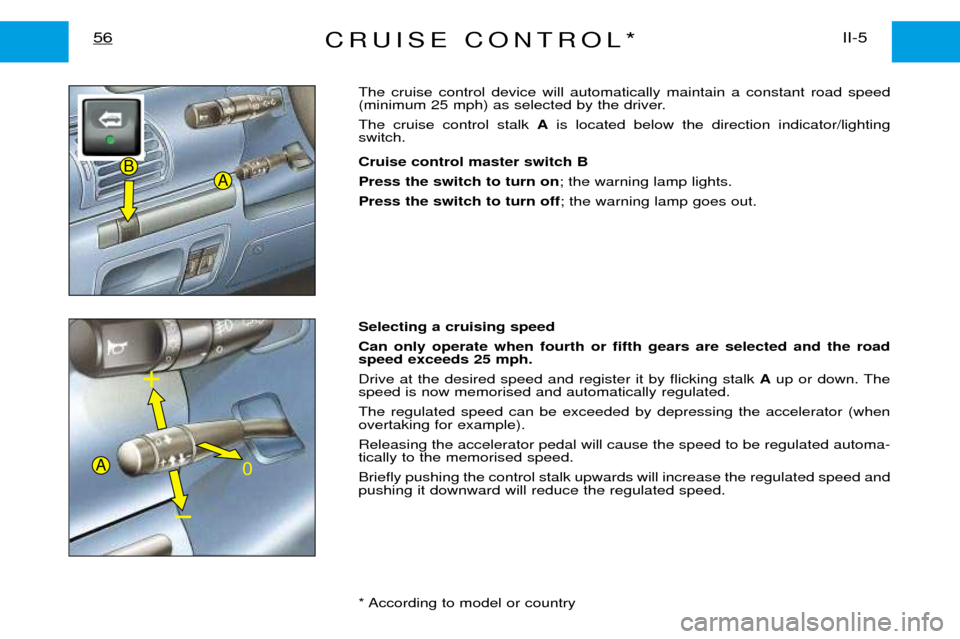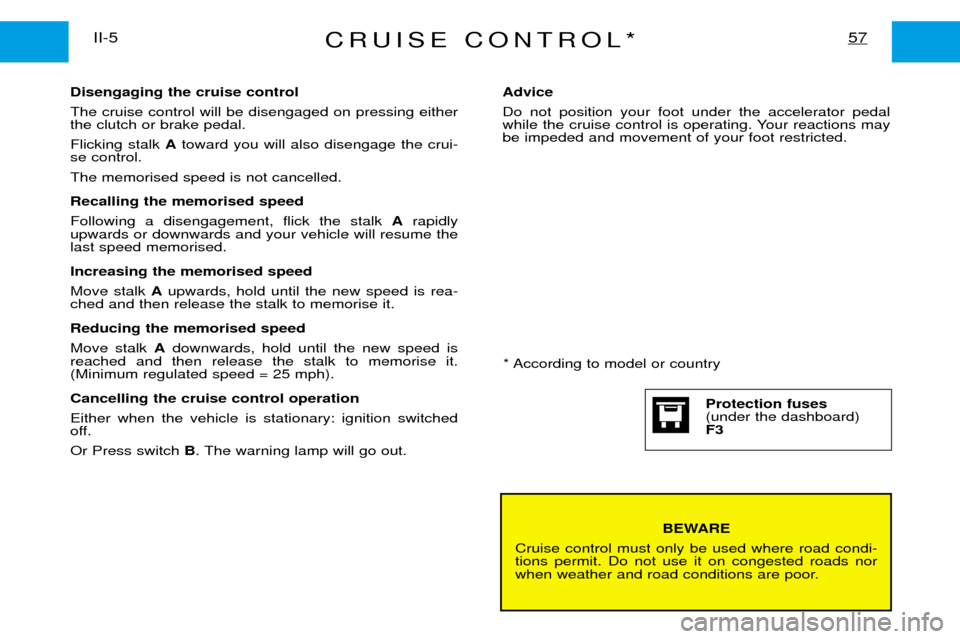Page 64 of 149
STEERING LOCK - IGNITION - STARTERII-1
50
¥ S : Steering lock
To free the steering, turn the steering wheel slightly at the same time as tur- ning the key; avoid using undue force.
¥ A : Accessories
Allows certain electrical accessories to be used. The battery charge warning lamp illuminates.
¥ M : Ignition The following warning lamps should come on: battery charge, handbrake, oil
pressure, engine coolant temperature According to the specific version of
vehicle, the following warning lamps should also come on: Stop, ABS, Engineautodiagnostic, Preheating (Diesel), Front airbag. If one of these lamps fails to light, it could indicate a fault in the system concerned. ¥ D : Starter Release the key as soon as the engine has started. Never operate with the engine running.
These warning lamps are tested with the ignition key in the ignition on position.
Page 65 of 149

STEERING LOCK - IGNITION - STARTER51II-1
WARNING
NEVER REMOVE THE IGNITION KEY BEFORE THE VEHICLE IS COMPLETELY STATIONARY. NEVER ATTEMPT TO MOVE THE VEHICLE BEFORE STARTING THE ENGINE AND WAITING FOR THE HYDRAULIC LOW PRESSURE WAR-
NING LAMP TO GO OUT. IF THE ENGINE IS NOT RUNNING, THE STEERING
WILL NOT HAVE POWER ASSISTANCE AND THERE MAY BE NO RESERVE OF PRESSURE AVAILABLE TO OPERATE THE FOOTBRAKE. THERE IS ALSO ARISK OF THE STEERING LOCK ENGAGING AND THE SAFETY FEATURES NOT OPERATING IF THE IGNITION IS NOT SWITCHED ON. ONLY IN AN
EMERGENCY SITUATION SHOULD YOU ATTEMPT TO MOVE A VEHICLE
WITHOUT STARTING THE ENGINE. TAKE ALL THE NECESSARY SAFETY
PRECAUTIONS AND BE PREPARED TO USE THE PARKING BRAKE TO STOP THE VEHICLE.
When parking, remove the ignition key and turn the steering wheel until the steering column locking peg engages.
Steering lock
S With the key removed and the steering lock peg engaged, the steering column is locked; the lock peg will engage in
a number of positions of the steering wheel. The key can only be removed in position S.
A The steering is unlocked - to enable the key to be turned to position A, it may be necessary to turn the steering slightly.
M Running position.
D Starting position.
For starting and stopping the engine, see Ç Starting È.
Page 67 of 149
STARTING53II-2
WARNING
DO NOT RUN THE ENGINE IN AN ENCLOSED OR POORLY VENTILATED AREA
DIESEL Starting the engine
Turn the ignition key to the ignition position. Wait for the preheater lamp to go out, then operate the starter motor until the engine starts.
If the engine does not start, switch off the ignition and start again.At temperatures below 0¡C, depress the clutch pedal to ease starting. Release the pedal slowly when the engine has started. Note:
Do not depress the accelerator pedal while operating the starter.
Advice
Vehicles equipped with a Turbo:
Turbo equipped engines MUST be allowed to return to idle for several seconds before switching off the ignition. Failure to do so could cause serious damage to the turbo unit.
Flicking the throttle pedal as the ignition is turned off can lead to severe damage to the turbo unit.
Page 68 of 149
BRAKESII-3
54
Handbrake
To create a passage between the front seats, the handbrake lever is mounted
to the left of the driverÕs seat. The handbrake is operated by pulling the lever firmly up - pressing the foot-
brake will reduce the effort required to apply the handbrake. The handbrake is capable of holding the vehicle on all slopes likely to be
encountered but increased effort will be needed on steep slopes.
In all circumstances, as a precautionary measure, engage first gear.On steep slopes, turn the steering towards the kerb.
To release the brake, pull the lever lightly up, press the button on the end of the lever and return the lever to the fully down position. The warning lamp will come on if the handbrake is on or not fully released when the engine is running .
Page 70 of 149

CRUISE CONTROL*II-5
56
The cruise control device will automatically maintain a constant road speed
(minimum 25 mph) as selected by the driver. The cruise control stalk Ais located below the direction indicator/lighting
switch. Cruise control master switch B Press the switch to turn on ; the warning lamp lights.
Press the switch to turn off ; the warning lamp goes out.
Selecting a cruising speedCan only operate when fourth or fifth gears are selected and the road speed exceeds 25 mph. Drive at the desired speed and register it by flicking stalk Aup or down. The
speed is now memorised and automatically regulated.The regulated speed can be exceeded by depressing the accelerator (when overtaking for example). Releasing the accelerator pedal will cause the speed to be regulated automa- tically to the memorised speed. Briefly pushing the control stalk upwards will increase the regulated speed and pushing it downward will reduce the regulated speed.
* According to model or country
0A
AB
Page 71 of 149

CRUISE CONTROL*57II-5
BEWARE
Cruise control must only be used where road condi- tions permit. Do not use it on congested roads nor
when weather and road conditions are poor.
Disengaging the cruise control The cruise control will be disengaged on pressing either the clutch or brake pedal. Flicking stalk
Atoward you will also disengage the crui-
se control.The memorised speed is not cancelled. Recalling the memorised speed Following a disengagement, flick the stalk Arapidly
upwards or downwards and your vehicle will resume the last speed memorised. Increasing the memorised speed Move stalk Aupwards, hold until the new speed is rea-
ched and then release the stalk to memorise it. Reducing the memorised speed Move stalk Adownwards, hold until the new speed is
reached and then release the stalk to memorise it. (Minimum regulated speed = 25 mph). Cancelling the cruise control operation Either when the vehicle is stationary: ignition switched
off. Or Press switch B. The warning lamp will go out. AdviceDo not position your foot under the accelerator pedal
while the cruise control is operating. Your reactions maybe impeded and movement of your foot restricted.
* According to model or country
Protection fuses (under the dashboard)F3
Page 74 of 149
GEAR LEVERII-6
60
Automatic gearbox selection lever Move the selection lever to any of the functions ; the warning lamp for the func- tion selected will appear on the instrument panel screen.
Park Reverse gearNeutral Drive Operation in auto-active automatic mode Sequential forward drive Operation in sequential mode Snow programme Operation in Snow automatic mode
Page 75 of 149

GEAR LEVER61II-6
Starting position
The engine can only be started
when the lever is at position P or N.
A safety device ensures that starting is impossible in the other positions.
Park Do not engage until the vehicle is completely sta-
tionary. To avoid any
movement of the vehicle when par-ked, select position Pand apply the
handbrake firmly. Check that theselector is in the Pposition to ensure
that the driving wheels are locked. When leaving the vehicle, make
absolutely certain that the PARK orP position is selected.
Automatic gearboxes - safety mea-sures:
¥ The gear lever can only be disen- gaged from position Pif the brake
pedal is pressed down.
¥ An audible warning* sounds if the gear lever is not in position P
when a door is opened. Also works with the ignition switched
off. Reverse gear Engage only when statio- nary and with the footbra-
ke firmly applied. To avoid
any transmission snatch or harsh-ness, wait several seconds before
pressing the accelerator. Neutral Do not select this position,
even momentarily, whenthe vehicle is in motion.
Warning If N is selected inadvertently when the vehicle is moving,allow the vehicle to stop beforeengaging other functions.
* According to model or country